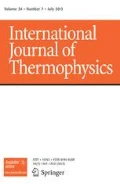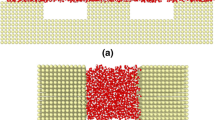Abstract
In this study, molecular dynamics method is used to estimate the atomic manner that effect on H2O/Cu Nanofluid behavior. The Copper Nanochannel with sphere barriers is simulated to study of H2O/Cu Nanofluid flow and the atomic interactions of these structures are described by Embedded Atom Model and Lennard-Jones force fields. For study of atomic behavior of these structures, physical parameters such as temperature, density and velocity profiles of Nanofluid reported. Molecular dynamics simulation results show that these parameters of H2O/Cu Nanofluid inside non-ideal Nanochannel affected by atomic barriers’ number and size changes. Numerically, we calculated the density and velocity profiles in Nanochannel with spherical barriers which show these numerical reports can be important for the heat transferring procedure in the industrial applications.











Similar content being viewed by others
References
K.Eric Drexler, Engines of creation: the coming era of nanotechnology (Doubleday, New York, 1986)
K.Eric Drexler, Nanosystems: molecular machinery, manufacturing, and computation (Wiley, New York, 1992)
R.A. Taylor et al., Small particles, big impacts: a review of the diverse applications of nanofluids. J. Appl. Phys. 113, 011301 (2013)
J. Buongiorno, Convective transport in nanofluids. J. Heat Transfer 128, 240 (2006)
W. Minkowycz et al., Argonne transportation technology R&D center nanoparticle heat transfer and fluid flow (CRC Press, Boca Raton, 2013)
S.K. Das, U.S. Stephen, S. Choi, Y. Wenhua, T. Pradeep, Nanofluids: Science and Technology (Wiley, New Yor, 2007), p. 397
S. Witharana, H. Chen, Y. Ding, Stability of nanofluids in quiescent and shear flow fields. Nanoscale Res. Lett. 6, 231 (2011)
H. Chen, S. Witharana et al., Predicting thermal conductivity of liquid suspensions of nanoparticles (nanofluids) based on rheology. Particuology. 7, 151–157 (2009)
D.M. Forrester et al., Experimental verification of nanofluid shear-wave reconversion in ultrasonic fields. Nanoscale. 8, 5497–5506 (2016)
N.A. Jolfaei, N.A. Jolfaei, M. Hekmatifar, A. Piranfar, D. Toghraie, R. Sabetvand, S. Rostami, Investigation of thermal properties of DNA structure with precise atomic arrangement via equilibrium and non-equilibrium molecular dynamics approaches. Comput. Methods Programs Biomed. 105, 169 (2019)
R. Sabetvand, M.E. Ghazi, M. Izadifard, Studying temperature effects on electronic and optical properties of cubic CH3NH3SnI3 perovskite. J. Comput. Electron. 19, 70–79 (2020)
N.A. Jolfaei, N.A. Jolfaei, M. Hekmatifar, A. Piranfar, D. Toghraie, R. Sabetvand, S. Rostami, Investigation of thermal properties of DNA structure with precise atomic arrangement via equilibrium and non-equilibrium molecular dynamics approaches. Comput. Methods Prog. Biomed. 105, 169 (2019)
M. Goel, S.P. Harsha, S. Singh, A.K. Sahani, Analysis of temperature, helicity and size effect on the mechanical properties of carbon nanotubes using molecular dynamics simulation. Mater. Today 10, 255 (2020)
D. Toghraie, M. Hekmatifar, Y. Salehipour, M. Afrand, Molecular dynamics simulation of Couette and Poiseuille Water–Copper nanofluid flows in rough and smooth nanochannels with different roughness configurations. Chem. Phys. 527, 110505 (2019)
A.V. Kuznetsov, D.A. Nield, Natural convective boundary-layer flow of a nanofluid past a vertical plate. Int. J. Therm. Sci. 49, 243–247 (2010)
Ziarani AS, Mohammad AA (2006) Development of qualitative rules for simulation disturbances and actions in a Modeling and simulation of double-pass sheet-and-tube solar water heaters. In: 17th International conference modeling and simulation, Canada, pp 585–590
C. Kunert, J. Harting, Simulation of fluid flow in hydrophobic rough microchannels. Int. J. Comput. Fluid Dyn. 22, 475–480 (2008)
A.S. Ziarani, A.A. Mohamad, Effect of wall roughness on the slip of fluid in a microchannel. Nanoscale Microscale Thermophys. Eng. 12, 154–169 (2008)
F.D. Sofos, T.E. Karakasidis, A. Liakopoulos, Effects of wall roughness on flow in nanochannels. Phys. Rev. E 79, 2 (2009)
N. Asproulis, D. Drikakis, Surface roughness effects in micro and nanofluidic devices. J. Comput. Theor. Nanosci. 7, 1825–1830 (2010)
Y. Li, J. Xu, D. Li, Molecular dynamics simulation of nanoscale liquid flows. Microfluid. Nanofluid. 9, 1011–1031 (2010)
R. Kamali, A. Kharazmi, Molecular dynamics simulation of surface roughness effects on nanoscale flows. Int. J. Therm. Sci. 50, 226–232 (2011)
G. Tertsinidou, M.J. Assael, W.A. Wakeham, Int. J. Thermophys. 36, 2 (2015). https://doi.org/10.1007/s10765-015-1856-9
M.A. Taghikhani, Int. J. Thermophys. 1, 1 (2019). https://doi.org/10.1007/s10765-019-2507-3
F. Nasirzadehroshenin, H. Maddah, H. Sakhaeinia et al., Int. J. Thermophys. (2019). https://doi.org/10.1007/s10765-019-2551-z
R. Tariq, Y. Hussain, N.A. Sheikh et al., Int. J. Thermophys. (2020). https://doi.org/10.1007/s10765-020-2619-9
B. Wang, W. Sheng, X. Peng, Int. J. Thermophys. (2009). https://doi.org/10.1007/s10765-009-0673-4
S. Eiamsa-ard, K. Kiatkittipong, Int. J. Thermophys. (2019). https://doi.org/10.1007/s10765-019-2485-5
S. Malekian, E. Fathi, N. Malekian et al., Int. J. Thermophys. (2018). https://doi.org/10.1007/s10765-018-2422-z
M.J. Assael, C.F. Chen, I. Metaxa, W.A. Wakeham, Int. J. Thermophys. (2004). https://doi.org/10.1023/B:IJOT.0000038494.22494.04
T. Schlick, pursuing Laplace’s vision on modern computers, in Mathematical applications to biomolecular structure and dynamics, IMA volumes in mathematics and its applications, vol. 82, ed. by J.P. Mesirov, K. Schulten, D.W. Sumners (Springer, New York, 1996), pp. 218–247
B.J. Alder, T.E. Wainwright, Studies in molecular dynamics. I. General method. J. Chem. Phys. 31, 459 (1959)
A. Rahman, Correlations in the motion of atoms in liquid argon. Phys. Rev. 136, A405–A411 (1964)
J.B. Gibson, A.N. Goland, M. Milgram, G.H. Vineyard, Dynamics of radiation damage. Phys. Rev. 120, 1229–1253 (1960)
S. Plimpton, Fast parallel algorithms for short range molecular dynamics. J Comp Phys 117, 1–19 (1995)
T.W. Sirk, S. Moore, E. Brown, F, Characteristics of thermal conductivity in classical water models. J Chem Phys 138, 123–137 (2013)
S.J. Plimpton, A. Thompson, P, computational aspects of many body potentials. MRS Bull. 37, 513–521 (2012)
S. J. Plimpton, R. Pollock, M. Stevens. In: Proc of the Eighth SIAM conference on parallel processing for scientific computing, Minneapolis, MN 223–245 (1997)
Brown. W. M, Wang. P, S. J. Plimpton, Tharrington. A. N, Implementing Molecular Dynamics on Hybrid High Performance Computers Short-Range Forces, Comp Phys Comm, 182, 898–911 (2011)
M.K. Gilson, K.A. Sharp, B.H. Honig, Calculating the electrostatic potential of molecules in solution: method and error assessment. J. Comput. Chem. 9, 327–335 (1988)
J.E. Lennard-Jones, On the determination of molecular fields. Proc. R. Soc. Lond. A 106, 463–477 (1924)
M.S. Daw, M. Baskes, Embedded-atom method: derivation and application to impurities, surfaces, and other defects in metals. Physical review B. Am. Phys. Soc. 29, 6443–6453 (1984)
A.K. Rappe, C.J. Casewit, K.S. Colwell, W.A. Goddard, W.M. Skiff, UFF, a full periodic table force field for molecular mechanics and molecular dynamics simulations. J. Am. Chem. Soc. 114, 10024–10035 (1992)
H.J.C. Berendsen, J.P.M. Postma, W.F. van Gunsteren, J. Hermans, Interaction models for water in relation to protein hydration. Intermolecular Forces 1981, 331–342 (1981)
Author information
Authors and Affiliations
Corresponding author
Ethics declarations
Conflict of interest
There is no conflict of interest.
Additional information
Publisher's Note
Springer Nature remains neutral with regard to jurisdictional claims in published maps and institutional affiliations.
Rights and permissions
About this article
Cite this article
Asgari, A., Nguyen, Q., Karimipour, A. et al. Develop Molecular Dynamics Method to Simulate the Flow and Thermal Domains of H2O/Cu Nanofluid in a Nanochannel Affected by an External Electric Field. Int J Thermophys 41, 126 (2020). https://doi.org/10.1007/s10765-020-02708-6
Received:
Accepted:
Published:
DOI: https://doi.org/10.1007/s10765-020-02708-6




